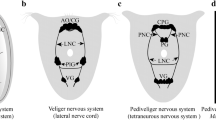Abstract
The nervous system of the polyclad turbellarian Notoplana acticola consists of a series of nerve plexuses and a central ganglion, the brain. The brain contains a variety of cell types including multipolar heteropolar and bipolar neurons. These cell types are rare in other invertebrate ganglia. Individual neurons also contain a variety of different ion channels. both spiking and nonspiking neurons are found. Some neurons are multimodal interneurons. Habituation appears to be a postsynaptic phenomenon. Sensitization and long-term potentiation have not been demonstrated. Polyclads appear to represent a stage in the evolution of centralized nervous systems where much of the neuronal machinery underlying behavior occurs in the peripheral nervous system and the brain's main functions are the coordination and sequencing of peripherally placed reflexes. Even at this stage, however, the brain already contains cells that seem as advanced as those found in higher organisms.
Similar content being viewed by others
References
Bernardo, K., G. C. Stone & H. Koopowitz, 1977. Primitive nervous systems: habituatio in decerebrate flatworms. J. Neurobiol. 8: 141–150.
Bullock, T. H. & G. A. Horridge, 1965. Structure and function in the nervous systems of invertebrates. 1. Freeman, San Francisco, 798 pp.
Carew, T. J., 1984. An introduction to cellular approaches used in the analysis of habituation and sensitization in Aplysia. In H. V. S. Peeke & L. Petrinovich (eds), Habituation, Sensitization and Behavior. Academic Press, N.Y.: 205–249.
Coss, R. G. & A. Globus, 1978. Spine stems on tectal interneurons in jewel fish are shortened by social stimulation. Science 200: 787–790.
Faisst, J., L. Keenan & H. Koopowitz, 1980. Neuronal repair and avoidance behavior in the flatworm, Notoplana acticola. J. Neurobiol. 11: 483–496.
Gruber, S. A. & D. W. Ewer, 1962. Observations on the myoneural physiology of the polyclad Planocera gilchristi. J. exp. Biol. 39: 459–477.
Hadenfeldt, D., 1929. Das Nervensystem von Stylochoplana maculata und Notoplana atomata. Z. wiss. Zool. 133: 586–638.
Kandel, E. & J. Schwartz, 1982. Molecular biology of learning: modulation of transmitter release. Science 218: 433–443.
Keenan, L. & H. Koopowitz, 1981. Tetrodotoxin-sensitive potentials from the brain of the polyclad flatworm, Notoplana acticola. J. exp. Zool. 215: 209–213.
Keenan, C. L. & H. Koopowitz, 1982. Postsynaptic habituation in identified flatworm neurones. Soc. Neurosci. Abst. 8: 161.
Keenan, C. L. & H. Koopowitz, 1983. Postsynaptic-cell membrane events accompanying habituation. Soc. Neurosci. Abst. 9: 733.
Keenan, C. L. and H. Koopowitz, 1984. Ionic bases of action potentials in identified flatworm neurones. J. comp. Physiol. A. 155: 197–208.
Keenan, L., Coss, R. G. & H. Koopowitz, 1981. Cytoarchitecture of primitive brains: Golgi studies on flatworms. J. comp. Neurol. 195: 697–716.
Koopowitz, H., 1970. Feeding behavior and the role of the brain in the polyclad flatworm, Planocera gilchristi. Anim. Behav. 18: 31–35.
Koopowitz, H., 1974. Some aspects of the physiology and organization of the nerve plexus in polyclad flatworms. In N. W. Riser & M. P. Morse (eds), Biology of the Turbellaria. McGraw-Hill, N.Y.: 198–212.
Koopowitz, H., 1982. Free-living Platyhelminthes. In G. A. B. Shelton (ed.), Electrical Conduction and Behaviour in ‘Simple’ Invertebrates. Oxford University Press, Oxford: 359–392.
Koopowitz, H. & L. Keenan, 1982. The primitive brains of the Platyhelminthes. Trends Neurosci. 5: 77–79.
Loeb, J., 1907. Comparative physiology of the brain and comparative psychology. G. P. Putman's Sons, N.Y.: 72–83.
Lynch, G. & M. Baudry, 1984. The biochemistry of memory: a new and specific hypothesis. Science 224: 1057–1063.
Pearson, K. G., 1976. Nerve cells without action potentials. In J. C. Fentress (ed.), Simpler networks and behavior. Sinauer Assoc. Inc., Sunderland: 99–110.
Reuter, M., 1981. The nervous system of Microstomum lineare (Turbellaria, Macrostomida). II. The ultrastructure of synapses and neurosecretory release sites. Cell Tissue Res. 218: 375–387.
Reuter, M. & P. Lindroos, 1979a. The ultrastructure of the nervous system of Gyratrix hermaphroditus (Turbellaria, Rhabdocoela). I. The brain. Acta zool. 60: 139–152.
Reuter, M. & P. Lindroos, 1979b. The ultrastructure of the nervous system of Gyratrix hermaphroditus (Turbellaria, Rhabdocoela). II. The peripheral nervous system and the synapses. Acta zool. 60: 153–161.
Reuter, M., M. Wikgren & I. Palmberg, 1980. The nervous system of Microstomum lineare (Turbellaria, Macrostomida). Cell Tissue Res. 211: 31–40.
Rieger, R. M., 1981. Morphology of the Turbellaria at the ultrastructural level. In E. R. Schockaert & I. R. Ball (eds), The Biology of the Turbellaria. Dr. W. Junk, The Hague: 213–229.
Solon, M. H. & H. Koopowitz, 1982. Multimodal interneurons in the polyclad flatworm, Alloeoplana californica. J. comp. Physiol. 145: 171–178.
Spencer, A. N. & R. A. Satterlie, 1980. Electrical and dye-coupling in an identified group of neurons in a coelenterate. J. Neurobiol. 11: 13–19.
Spitzer, N. C., 1984. What do Rohon-Beard cells do? Trends Neurosci. 7: 224–225.
Vanegas, H., M. Laufer & J. Amat, 1974. The optic tectum of a perciform Teleost I. General configuration and cytoarchitecture. J. comp. Neurol. 154: 43–60.
Zucker, R., 1972. Crayfish escape behavior and central synapses. II. Physiological mechanisms underlying behavioral habituation. J. Neurophys. 35: 621–637.
Author information
Authors and Affiliations
Rights and permissions
About this article
Cite this article
Koopowitz, H. On the evolution of central nervous systems: Implications from polyclad turbellarian neurobiology. Hydrobiologia 132, 79–87 (1986). https://doi.org/10.1007/BF00046232
Issue Date:
DOI: https://doi.org/10.1007/BF00046232




